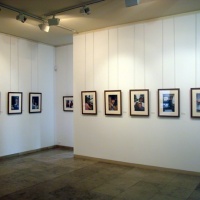Category: PAST EXHIBITIONS
EXHIBITIONS
June 27, 2008 – July 30, 2008
The public release of the photographic processes in 1839 first enabled the depiction of nature, seemingly free of interpretation. With immediate effect, photography became an essential medium of conveying and sharing works of art. While until then the camera obscura or camera lucida were in use, requiring a skilled draftsman to put the image to paper, the photographic process made light itselfthe draftsman and nature could create it’s own reproduction.
By 1839 it was possible, in effect, for art-enthusiasts to view works of art „in natura“. Demand was soon made for images of objects more distant and inaccessible. Art and travel enthusiasts wanted the privilege of seeing reproductions of the distant treasures of the world, among which were the Capitoline Venus and the Sphinx.
Unlike today, a photographic image of a work of art was no reproduction, but a precious original.
Though at first travelling artists like Itier, Du Camp, and Bisson Frères met the great demand for views of foreign treasures, they were later replaced by professional resident photographers.
The photographer has considerable ability to give the image his personal artistic stamp. Antiquities were monumentalized, often disappointing travellers to the original. Never will antique Rome seem as spectacular as in those photos of Anderson, Mac Pherson or Molins.
October 11, 2007 – October 14, 2007
On the occasion of Munich Highlights (October 11th — 14th, 2007), Galerie Daniel Blau is proud to open its exhibition “A.R. Penck — Paintings and Drawings from the 60s and 70s”.
A.R. Penck, born Ralf Winkler 1939 in Dresden, is a central figure in German art of the post-war era, as recently demonstrated by the major retrospective shown in Frankfurt, Kiel and Paris.His abstracted figures, the “stickmen”, and mystical symbols, common to his pre-1980 works, created before his expatriation to West Germany, originated from his interest in prehistoric painting and hieroglyphs. His artist’s name is adopted from the Geologist and Geographer Albrecht Penck. A.R. Penck’s “Standart” — works are concerned with, in a most fundamental manner, individuals in their society.
The gallery will be exhibiting Penck’s early works, still created in the GDR. These paintings mark a crucial phase in Penck’s artistic development.
September 12, 2003 – October 31, 2003
December 3, 2004 – January 30, 2005
July 7, 2010 – July 30, 2010
Glen Baxter
Christa Dichgans
Neal Fox
Dan McCarthy
Matt Mullican
Don van Vliet
Andy Warhol
u. a.
December 23, 2010
A selection of fine and rare pictures from the early years of photography, 1839-1859. As a parallel exhibition at Paris Photo, we will show unusual and rare portraits from the 1850’s by artists like Roger Fenton, Charles Marville or Charles Nègre.
October 8, 2010 – November 11, 2010
Infamous for their Fuck Faces and their gruesome Hell and Fucking Hell war-landscapes, the Chapman brothers made their first big appearance in 1997 at the Sensation exhibition in the Royal Academy of Art. These stars of the London art scene will now be coming to Munich to put on Cained and Disabled, the next chapter, an exhibition comprised of sculptures from the “Litte Death Machines” series, as well as portraits, à la Dorian Gray, from the cycle One Day You Will No Longer Be Loved.
Dinos Chapman was born 1962 in London and Jake Chapman 1966 in Cheltenham. Dinos studied painting and Jake sculpting at the Royal College of Art in London. Their works have been shown in important museums around the world (Tate, London, Groninger Museum, Groningen etc.) and can be found in notable international collections, such as those of the Museum of Modern Art in New York, the Tate Gallery in London, the Museum Kunst Palastin Düsseldorf and the Palazzo Grassi in Venice.
Jake and Dinos live and work in London.
May 2, 2008 – May 24, 2008
September 13, 2008 – October 6, 2008
In the weeks from the 13th of September to the 6th of October the Gallery Daniel Blau will be exhibiting works by Neal Fox, a young artist from London and recent introduction to the art world.
Fox’s artistic roots lie with illustration as with the experiences and tales he gathered from a complex web of characters ranging from the beat poets Allen Ginsberg and Gregory Corso to Francis Bacon, Andy Warhol, Grace Jones and the occulist Aleister Crowley.
The same pubs and haunts in Soho that became the gathering points for London’s artistic, bohemian and alcoholic culture, of which Fox’s grandfather was a part, are now frequented by Neal Fox and a new generation of eccentric minds. The remarkable life of his grandfather, John Watson, inspired Mr. Fox as a teenager to explore the myths of a life as a WWII bomber pilot in Germany, a writer of several novels and some “trashy paperbacks about cowboys and gangsters,” a chat show host, publisher and drinker in Soho.
Fox’s earliest illustrations were based on his grandfather’s books, and Watson still appears in most of his ink drawings, always dressed in a dark trenchcoat holding a drink and looking on as mastiffs attack a bear in an Elizabethan arena or flying a helicopter filled with playmates, as a a naked Oliver Reed and a peg-legged Keith Moon engage in a vicious swordfight.
The large inks on paper by the twenty-six year old artist show scenes of apomorphium hallucinations, trainrides through Europe, and surreal depictions of Andy Warhol, Basquiat and Truman Capote at the infamous Studio 54. The viewers’ glances are seemingly returned by some of the subjects in the drawings, and one is thus introduced as a photographic voyeur to the distorted perspectives of Neal Fox’s fantastical illustrated trips.
June 29, 2007 – July 28, 2007






 +49 89 29 73 42
+49 89 29 73 42